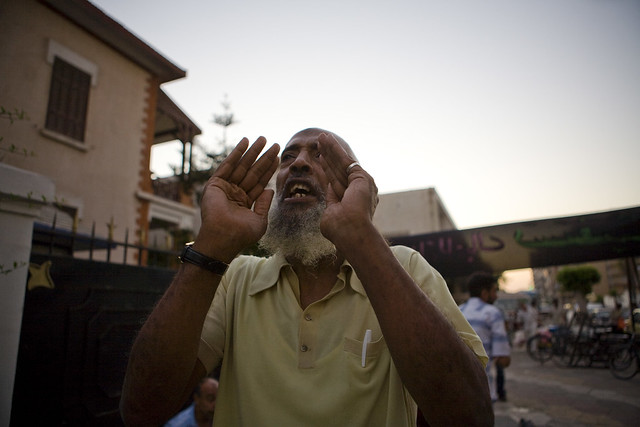I took the pic above Tuesday in Port Said, as the Canal Ropes Company strikers were about to break their Ramadan fast at sunset. The worker in the ground reaching with his hand to take the dates is a Coptic worker, named Labib Guergiss (Also seen in the pic below).
Virtually all workers I meet during strikes, including their leaders, tend to be religiously devout. Many of the Muslims have beards, prayer marks on their foreheads (zebiba), and pray regularly.
The women workers are usually dressed in higab, if not niqab.
The Copts have crosses tattooed on their arms, a practice common among middle and working class Christians. The religiosity however does NOT translate itself mechanically into:
1- Sectarian attitude among the workers from two sects: On the contrary, unity is strongly forged among the strikers, and among the newly rising layer of strike leaders there is a significant number of Copts.
2- A political affiliation or sympathy to the Muslim Brotherhood: No, the biggest and most organized opposition force, as the cliche goes, is not active among labor circles. Its base of support lies mainly among the middle class professionals, lower middle classes and the Islamized sections of our elite. Their capitalist economic agenda, and vague oscillating stands towards privatization, weak intervention on behalf of workers in industrial conflicts that erupt in their parliamentarian constituencies and the general retreat the organization is going through since the 2006 crackdown, means an confused stand towards the strike wave. I usually ask strike leaders I interview on their views regarding the MBs. The responses vary from overt hostility to “they are good people. They do charity.” But in almost all cases, the strikers cite no direct help from the group, let alone leadership.
3- Hostility to the left: Being religious, contrary to the stereotype, does not mean a hostility to leftists and secular activists. Unlike the liberal secularists, radical leftists have a different stand towards religion, and do not put religion as the enemy or as the focal point of the current malaise. I found the workers themselves when they are struggling, to be welcoming to any sincere effort to help them, whether it’s coming from a secular, an Islamist or the devil. What matters for them is who does what during the strike to make it successful? Who stands by them, who stands against them? Who puts 110% effort into a solidarity campaign with them, and who doesn’t give a shit? Some of the strike leaders I know in industrial and service sectors are increasingly describing themselves as “socialists” or “Marxists” while carefully observing the prayer timings, fasting Ramadan, and have zebibas on their foreheads. Personally they are religious, but the political program they present and advocate is left-leaning and secular. There is a clear shift in the mood among the workers and public to the left. It’s been a slow, incremental change that started with the outbreak of the Palestinian intifada eight years ago… a change that has been missed by the Western journalists and researchers obsessed with stories on terrorism, the veiled oppressed women, and the Red Sea Rivera.
4- Subordination of women in the industrial action: The participation of the women workers in the strike wave is an amazing story. They triggered the Winter of Labor Discontent, produced strike leaders and trade union activists, and are defying established gender roles. A Westernized feminist who looks at the pix of the strikers and finds the women to be veiled or in niqab and thus draws a negative conclusion about their status, will miss the whole point.



